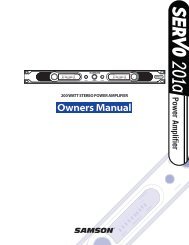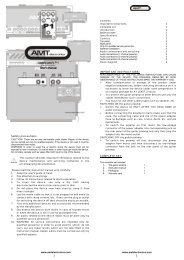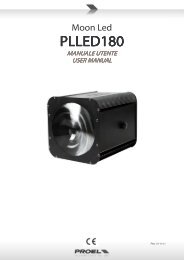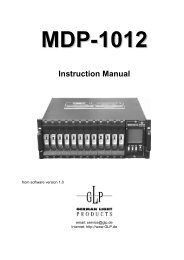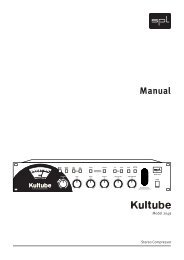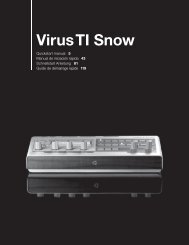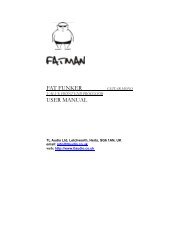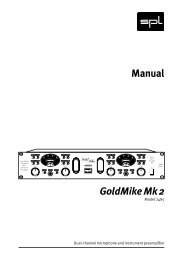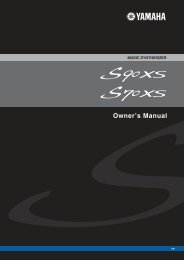Congratulations on your purchase of the Stereo Pulsar, a variable ...
Congratulations on your purchase of the Stereo Pulsar, a variable ...
Congratulations on your purchase of the Stereo Pulsar, a variable ...
You also want an ePaper? Increase the reach of your titles
YUMPU automatically turns print PDFs into web optimized ePapers that Google loves.
<str<strong>on</strong>g>C<strong>on</strong>gratulati<strong>on</strong>s</str<strong>on</strong>g> <strong>on</strong> <strong>your</strong> <strong>purchase</strong> <strong>of</strong> <strong>the</strong> <strong>Stereo</strong> <strong>Pulsar</strong>, a <strong>variable</strong><br />
shape tremolo and panner pedal.<br />
C<strong>on</strong>nected as a m<strong>on</strong>o pedal, <strong>the</strong> <strong>Stereo</strong> <strong>Pulsar</strong> is exactly <strong>the</strong> same<br />
as <strong>the</strong> Electro-Harm<strong>on</strong>ix <strong>Pulsar</strong> that we currently manufactur: a<br />
tremolo pedal that allows significant c<strong>on</strong>trol over <strong>the</strong> shape <strong>of</strong><br />
modulating waveform. Hook up <strong>the</strong> <strong>Stereo</strong> <strong>Pulsar</strong> in stereo (each<br />
output to a separate amp/mixer channel) and you have a panner<br />
pedal that will send <strong>your</strong> instrument back and forth between two<br />
amps with <strong>the</strong> same c<strong>on</strong>trol over waveform shape. So while <strong>on</strong>e<br />
amp is fading up in volume, <strong>the</strong> o<strong>the</strong>r will be fading down in volume<br />
or even more dramatic: while <strong>on</strong>e amp is <strong>on</strong>, <strong>the</strong> o<strong>the</strong>r is <strong>of</strong>f.<br />
— CONTROLS —<br />
SHAPE Switch – Selects between Triangle Wave and Square Wave Modes.<br />
SHAPE Knob – Changes <strong>the</strong> shape <strong>of</strong> <strong>the</strong> waveform that modulates <strong>the</strong> Tremolo.<br />
Triangle Wave Mode – In this mode <strong>the</strong> LFO creates a Triangle Wave<br />
oscillati<strong>on</strong>, resulting in a smooth modulati<strong>on</strong>. As <strong>the</strong> SHAPE knob is turned<br />
from <strong>the</strong> Counter-Clockwise (minimum) positi<strong>on</strong> to <strong>the</strong> Center (middle)<br />
positi<strong>on</strong>, <strong>the</strong> waveform starts as a rising Sawtooth changing into a Triangle.<br />
From <strong>the</strong> Center positi<strong>on</strong> to <strong>the</strong> Clockwise (maximum) positi<strong>on</strong>, <strong>the</strong> wave<br />
changes from a Triangle to a falling Sawtooth.
Square Wave Mode – In this mode, <strong>the</strong> LFO creates a Square Wave,<br />
resulting in a sharp, <strong>on</strong>/<strong>of</strong>f modulati<strong>on</strong>. As <strong>the</strong> SHAPE knob is turned from<br />
<strong>the</strong> Counter-Clockwise (minimum) positi<strong>on</strong> to <strong>the</strong> Center (middle) positi<strong>on</strong>,<br />
<strong>the</strong> wave starts as a Small Pulse Width Wave changing into a Square Wave.<br />
From <strong>the</strong> Center positi<strong>on</strong> to <strong>the</strong> Clockwise (maximum) positi<strong>on</strong>, <strong>the</strong> wave<br />
changes from a Square Wave to a Large Pulse Width Wave.<br />
DEPTH Knob – Adjusts <strong>the</strong> amount <strong>of</strong> Tremolo that will be applied to <strong>your</strong> signal.<br />
As <strong>the</strong> DEPTH knob is turned from <strong>the</strong> Counter-Clockwise (minimum) positi<strong>on</strong> to<br />
<strong>the</strong> Clockwise (maximum) positi<strong>on</strong>, <strong>the</strong> amount <strong>of</strong> <strong>the</strong> effect will increase. Maximum<br />
tremolo occurs when <strong>the</strong> DEPTH knob is set to approximately 2 o’clock. As <strong>the</strong><br />
DEPTH knob is turned above 2 o’clock, <strong>the</strong> tremolo begins to warp by modulating<br />
between positive and negative phase with a rhythmic pattern. To obtain maximum<br />
pan when using <strong>the</strong> <strong>Stereo</strong> <strong>Pulsar</strong> in stereo, <strong>the</strong> optimum setting for <strong>the</strong> DEPTH knob<br />
is at approximately 2 o’clock.<br />
RATE Knob – Adjusts <strong>the</strong> speed <strong>of</strong> <strong>the</strong> tremolo or pan effect. As <strong>the</strong> RATE knob is<br />
turned from <strong>the</strong> Counter-Clockwise (minimum) positi<strong>on</strong> to <strong>the</strong> Clockwise<br />
(maximum) positi<strong>on</strong>, <strong>the</strong> modulati<strong>on</strong> rate increases.<br />
RATE/STATUS LED – If <strong>the</strong> effect is engaged, <strong>the</strong> LED will blink at <strong>the</strong> same rate<br />
that <strong>the</strong> effect modulates. In bypass mode, <strong>the</strong> LED is <strong>of</strong>f. The footswitch<br />
engages/disengages <strong>the</strong> effect.<br />
INPUT Jack – C<strong>on</strong>nect <strong>your</strong> instrument’s output to this ¼” m<strong>on</strong>o jack. The input<br />
impedance presented at this jack is 1 Mohm. Plugging a cable into <strong>the</strong> INPUT jack,<br />
when running <strong>the</strong> <strong>Stereo</strong> <strong>Pulsar</strong> <strong>of</strong>f <strong>of</strong> a 9V battery, turns <strong>the</strong> <strong>Stereo</strong> <strong>Pulsar</strong> <strong>on</strong> and<br />
drains <strong>the</strong> battery.<br />
MAIN OUT Jack – C<strong>on</strong>nect this ¼” m<strong>on</strong>o jack to <strong>your</strong> amplifier’s input. The<br />
output impedance presented at this jack is 1 kohm. When using <strong>the</strong> <strong>Stereo</strong> <strong>Pulsar</strong> as a<br />
m<strong>on</strong>o device we recommend you use <strong>the</strong> MAIN OUT jack so that <strong>the</strong> parameter<br />
labels <strong>of</strong> <strong>the</strong> SHAPE knob corresp<strong>on</strong>d to what <strong>your</strong> hear.<br />
STEREO OUT Jack – C<strong>on</strong>nect this ¼” m<strong>on</strong>o jack to <strong>your</strong> sec<strong>on</strong>d amplifier’s input.<br />
The output impedance presented at this jack is 1 kohm. When using <strong>the</strong> <strong>Stereo</strong> <strong>Pulsar</strong><br />
as a stereo device use <strong>the</strong> STEREO OUT jack for <strong>your</strong> sec<strong>on</strong>d channel. You can<br />
c<strong>on</strong>nect <strong>on</strong>ly <strong>the</strong> STEREO OUT jack if you want; <strong>the</strong> tremolo effect will be <strong>the</strong> same<br />
as from <strong>the</strong> MAIN OUT jack but <strong>the</strong> SHAPE knob labels will be reversed. For<br />
example, when <strong>the</strong> SHAPE knob is set to its clockwise positi<strong>on</strong>, <strong>the</strong> tremolo will<br />
have a falling sawtooth modulating it.<br />
used by Boss & Ibanez) 9.6 volts/DC 200mA. The battery eliminator must<br />
have a barrel c<strong>on</strong>nector with center negative. The battery may be left in or taken out<br />
when using an eliminator.<br />
- POWER -<br />
Power from <strong>the</strong> internal 9-volt battery is activated by plugging into <strong>the</strong> INPUT jack. The input<br />
cable should be removed when <strong>the</strong> unit is not in use to avoid running down <strong>the</strong> battery. If a<br />
battery eliminator is used, <strong>the</strong> <strong>Stereo</strong> <strong>Pulsar</strong> will be powered as l<strong>on</strong>g as a wall-wart is<br />
plugged into <strong>the</strong> wall.<br />
To change <strong>the</strong> 9-volt battery, you must remove <strong>the</strong> 4 screws <strong>on</strong> <strong>the</strong> bottom <strong>of</strong> <strong>the</strong> <strong>Stereo</strong><br />
<strong>Pulsar</strong>. Once <strong>the</strong> screws are removed, you can take <strong>of</strong>f <strong>the</strong> bottom plate and change <strong>the</strong><br />
battery. Please do not touch <strong>the</strong> circuit board while <strong>the</strong> bottom plate is <strong>of</strong>f or you risk<br />
damaging a comp<strong>on</strong>ent.<br />
- WARRANTY INFORMATION -<br />
Please complete and return <strong>the</strong> enclosed warranty card within 10 days <strong>of</strong> <strong>purchase</strong>. We will<br />
repair <strong>the</strong> unit for free within <strong>on</strong>e year <strong>of</strong> date <strong>of</strong> <strong>purchase</strong>. If you should need to return<br />
<strong>your</strong> unit for service within <strong>the</strong> warranty period, please include a brief descripti<strong>on</strong> <strong>of</strong> <strong>the</strong><br />
problem as well as <strong>your</strong> name, address, teleph<strong>on</strong>e number, copy <strong>of</strong> <strong>your</strong> receipt, and a<br />
check or m<strong>on</strong>ey order for $5.00 shipping and handling to:<br />
Electro-Harm<strong>on</strong>ix<br />
C/O New Sensor Corporati<strong>on</strong><br />
32-33 47 th Ave<br />
L<strong>on</strong>g Island City, NY 11101<br />
Att: Service Department<br />
Please make checks/m<strong>on</strong>ey orders payable to New Sensor Corporati<strong>on</strong>.<br />
To hear demos by rock stars <strong>on</strong> all EH pedals visit us <strong>on</strong> <strong>the</strong> web at www.ehx.com.<br />
Email us at info@ehx.com<br />
9V Power Jack – The <strong>Stereo</strong> <strong>Pulsar</strong> can run <strong>of</strong>f <strong>of</strong> a 9V battery or you can c<strong>on</strong>nect a<br />
9VDC battery eliminator capable <strong>of</strong> delivering at least 100mA to <strong>the</strong> 9V power jack.<br />
The opti<strong>on</strong>al 9V power supply from Electro-Harm<strong>on</strong>ix is US9.6DC-200BI (same as



